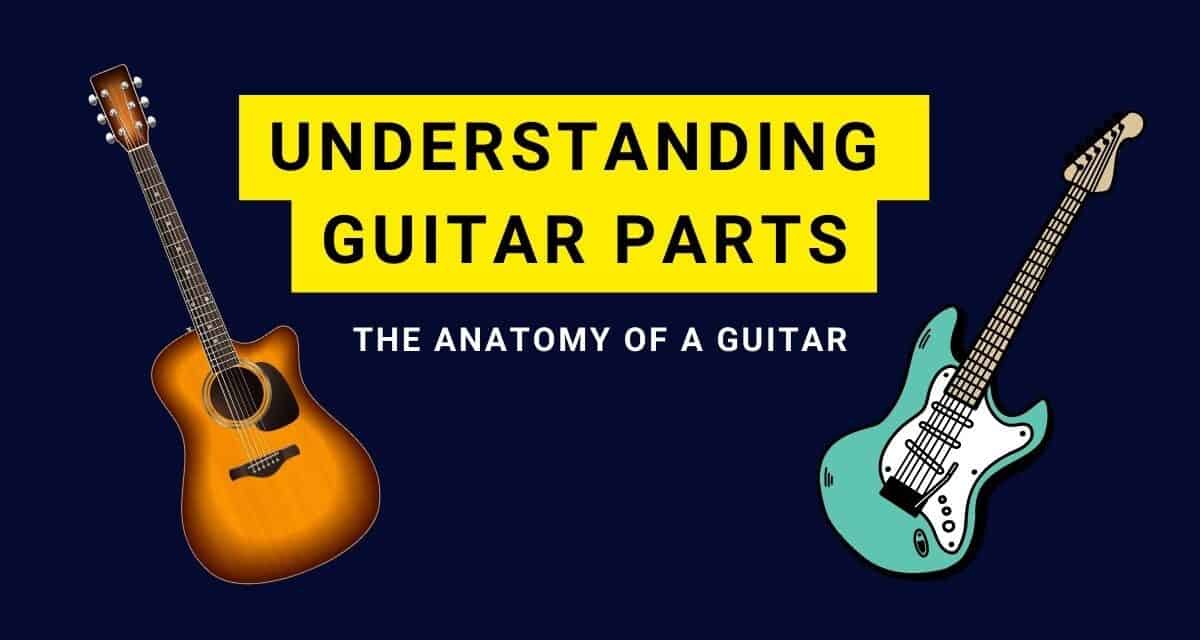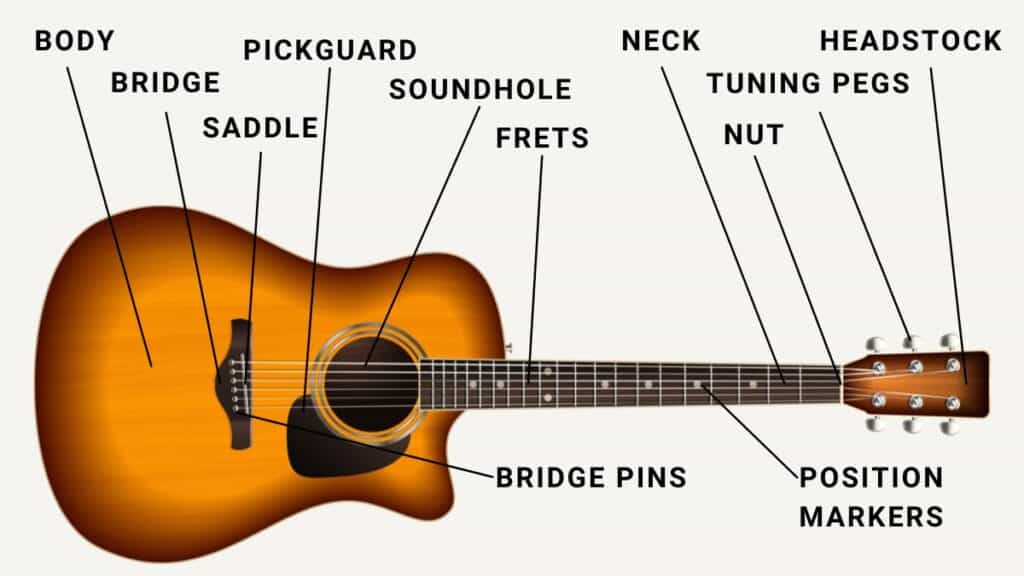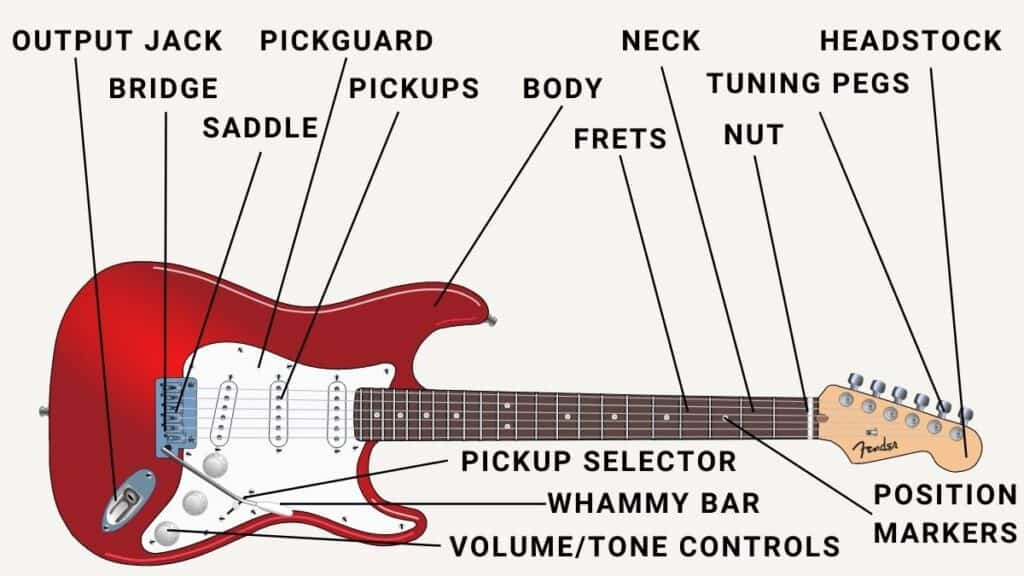Cue the stage lights and turn those amps to 11! Welcome to the wonderful world of guitar parts.
A captivating instrument, a guitar isn’t just a random assortment of strings and wood. It’s an intricately designed piece of musical machinery, each part playing its own role in producing those sweet, sweet sounds that have shaped the soundtrack of our lives.
From the resonating body to the tension-tightening tuning pegs, the gentle curve of the neck to the humble yet pivotal bridge, each component of a guitar contributes to its distinctive voice.
And whether you’re a newbie just getting your fingers in tune or a seasoned strummer looking to deepen your understanding, knowing these parts isn’t just useful, it’s essential – regardless of if you are playing an electric or acoustic guitar.
So strap in, grab your pick, and join us as we break down an acoustic guitar piece by piece, exploring each part’s purpose and how it contributes to making a guitar, well… a guitar! Ready? Let’s rock and roll!
Different Parts of an Acoustic Guitar
These standard guitar parts apply to all various acoustic guitars – from dreadnoughts to classical guitars.
Body
Picture the guitar in your mind’s eye. The first thing that likely pops up is that curvaceous, often glossy component that rests against your torso when you’re cranking out tunes—it’s the body!
This is where the magic happens.
It’s like the concert hall of the guitar where sound resonates. Acoustic and electric guitars differ here, with acoustic bodies being hollow (for that rich, resonant sound) and electric ones being solid or semi-hollow (for that amplified, buzzing charm).
The top layer of the body is known as the guitar top, or the ‘soundboard’.
This front-facing part of the guitar’s body isn’t just for looks; it’s the main resonating surface that transforms your string strums into the music we all know and love.
There are many different shapes of a guitar body but the purpose remains the same for each guitar although the shape may be attributed to a unique tone.
Bridge
Now, cast your gaze to the body of the guitar where we find one of the most important parts.
Notice the little wooden bar towards the bottom? That’s the bridge, my friends. Its job? To serve as the anchoring point for the strings. It’s the faithful lieutenant, holding the strings in place as they stretch over the soundhole and up towards the headstock. Without the bridge, those strings would be all over the place, and playing a tune would be about as easy as herding cats!
Bridge Pins
Ah, bridge pins. Small but mighty, they’re the unsung heroes of the guitar world. You’ll find these little guys snugly inserted in the bridge, securing the guitar strings in place.
Bridge pins work in tandem with the bridge to ensure your strings don’t go wandering off while you’re in the middle of your epic solo. Think of them as the bouncers of the guitar club, keeping everyone in line.
Saddle
Have you ever watched a cowboy movie? Well, like a saddle on a horse, the guitar saddle is where the action takes place!
Nestled on the bridge, the saddle is a thin strip—often made of bone, plastic, or synthetic material. The strings pass over it, creating a firm breakpoint.
The saddle helps control the strings’ height (known as action) and plays a critical role in the transmission of the strings’ vibrations to the guitar body. It’s like the conductor of the orchestra, making sure every vibration hits the right note.
Pickguard
Imagine you’re strumming your guitar, lost in the rhythm, and suddenly—gasp! You’ve left a nasty scratch right on its face. Ouch! That’s where our trusty friend, the pickguard, comes in. Typically found beneath the soundhole on acoustics and near the pickups on electrics, this piece of plastic shields your guitar’s finish from any strumming mishaps. It’s the superhero of the guitar world, protecting your precious instrument from the perils of passionate playing!
Sound hole
Now, here’s where the magic echoes out. The sound hole, that circular opening in the middle of an acoustic guitar’s body, is the exit point for the resonant sounds produced within the guitar. It’s like the guitar’s voice box. On electric guitars, you won’t find a sound hole as their sound is amplified electronically. For acoustics though, this guy is singing loud and clear.
Sometimes, you will notice a decorative inlaid pattern around the sound hole – this is known as the Rosette.
Frets
Slide your hand up the guitar’s neck. Feel those thin, metal strips running across? Those are your frets. These metallic speed bumps on your guitar’s neck are crucial for altering pitch. When you press a string down, the string hits a fret, shortening its length and raising its pitch. They’re the stepping stones of sound on your guitar, leading you up and down the scales.
These may need to be replaced over time as they get worn down – which can affect the tuning stability of the guitar.
Neck
Speaking of frets, let’s chat about their home—the guitar neck. The long, slender part of the guitar that houses the fretboard, or fingerboard, is called the neck. It’s the path that your fingers walk as they dance from note to note, creating beautiful music. Neck dimensions vary, influencing how a guitar feels to play and is often joined to the body by a neck joint.
There are three main types of neck shapes: the V shape, C shape, and U shape and the choice often comes down to personal preference.
Some like the guitar neck chunky, others like it slim and some prefer the scale length to be slightly larger— regardless of preference, there’s a guitar neck out there for every hand!
Nut
Don’t let the small size fool you, the nut is a crucial part of the guitar setup. Perched between the headstock and the neck, this thin piece determines the spacing of the strings and their height above the fretboard. It also helps maintain accurate intonation and sustain. Nuts can be made from various materials, including bone, plastic, and even metal. Remember, it’s not just a groovy guitar, it’s a finely tuned instrument!
Tuning Pegs (Tuning Keys)
Time to get in tune with tuning pegs! These little knobs on the headstock are what you turn when your guitar sounds a bit out of whack. Attached to the machine heads, tuners control the tension of the strings, thereby adjusting their pitch.
The machine heads are commonly made up of a string post, worm gear and pinion gear.
Rotate them one way to tighten the string (raising the pitch), and the other way to loosen it (lowering the pitch). Tune up, and let the good times roll!
Headstock
Now, let’s look at the guitar’s noggin—the headstock. This widened piece at the end of the neck is where you’ll find those aforementioned tuning pegs. It’s an important component, providing the counter-tension needed for the strings to vibrate. Plus, it usually sports the guitar maker’s logo, giving you those rockstar vibes.
Position Markers
Now, we explore the position markers, sometimes called fret markers. These are the small dots or shapes on your fretboard, and they’re basically your guitar’s version of GPS. They help you find your way around the neck by marking specific frets (usually the 3rd, 5th, 7th, 9th, 12th, 15th, 17th, 19th, 21st, and 24th). With these trusty guides, you can navigate the fretboard like a pro!
Truss Rod (Inside the Guitar Nech)
Hiding out in your guitar’s neck, we find the truss rod, an unsung hero of guitar anatomy. Truss rods runs the length of the neck, working tirelessly to counteract the substantial tension from the strings—up to 200 pounds on steel-stringed guitars!
The truss rod is no one-trick pony, though. It also lets you adjust the neck’s curvature, known as ‘relief’, to match your playing style and keep the instrument sounding swell. Prefer a buzz-free clean tone? Add some relief. Crave a little buzz in your blues? Go for a flatter neck.
But be warned, tweaking the truss rod is delicate work. Missteps can harm your guitar’s playability or even its structure. If unsure, a pro guitar tech’s advice is golden. The truss rod: unseen but essential, a silent partner in your melodious journey. Rock on!
Different Parts of an Electric Guitar
Electric guitars share many of the same components of an acoustic guitar but do have some different additional parts. These additional parts can be found on most electric guitars – whether you have a Les Paul brand guitar or a Stratocaster.
Pickups
The biggest difference between an electric and acoustic guitar is the pickup. A pickup is a magnetic device that translates the vibration of the strings into electrical signals, which can then be amplified.
Electric guitars usually have two or three pickups, each giving a unique sound depending on its position in relation to the strings.
Volume and Tone Controls
Electric guitars also have knobs for volume and tone control. The volume knob controls the output level of the signal sent to the amplifier.
The tone knob, on the other hand, controls the brightness or darkness of your sound. Turn it one way for a brighter, more treble-heavy sound.
Turn it the other for a darker, bass-heavy tone. These controls let you customize your sound without even touching your amp.
Pickup Selector
If your electric guitar has more than one pickup, you’ll have a pickup selector switch. This switch lets you choose which pickup(s) you’re using. You can select one pickup alone for a distinct sound or combine them for a broader tone.
Output Jack
Last but not least, the output jack. This is where you plug in your guitar cable to connect your electric guitar to an amplifier. It’s a small but essential part, as without it, we wouldn’t be able to hear the awesome riffs and solos that electric guitars are known for!
So while the basic structure of electric and acoustic guitars is similar, these unique parts give the electric guitar its distinctive character and versatility. Whether you’re about to bust out a sweet solo or lay down a crunchy riff, these parts of an electric guitar will make sure you’re heard!
Whammy Bar (Optional)
The whammy bar, also known as a tremolo arm, vibrato bar, or simply a “whammy”, is a metal lever attached to the bridge of some electric guitars. It’s a game-changer for guitarists looking to add some personality and dynamics to their sound.
When you push or pull the whammy bar, it changes the tension of the strings by subtly moving the bridge. This alters the pitch of the notes being played. A gentle nudge can give you a subtle vibrato effect, while a dramatic dive bomb can make your guitar wail like nothing else!
Used with a bit of finesse, the whammy bar can make your guitar sing, cry, scream – you name it. From the expressive vibrato of blues legend Buddy Guy to the dive-bomb antics of Eddie Van Halen, the whammy bar is a tool of great expressiveness and creativity.
Wrapping up the Anatomy of the Guitar
Understanding the anatomy of a guitar isn’t just a matter of geeky music trivia, but a key part of becoming a better musician. The more familiar you are with the ins and outs of your instrument, the more you can get the best out of it. Plus, it’s always handy when it comes to troubleshooting any hitches or understanding the ‘why’ behind certain sounds or techniques.
So, whether you’re just beginning your guitar journey or have already clocked in countless chords, we hope this article has struck a chord with you (pun totally intended!). Because when it comes to the world of guitars, knowledge truly does strike the best note.
Now, let’s quit this chit-chat and get back to the best part – playing! Because in the end, that’s what it’s all about. Rock on, guitar heroes!








